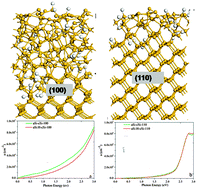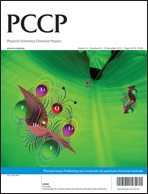Surface orientation effects in crystalline–amorphous silicon interfaces†
Abstract
In this paper we present the results of empirical potential and density functional theory (DFT) studies of models of interfaces between amorphous silicon (a-Si) or hydrogenated amorphous Si (a-Si:H) and crystalline Si (c-Si) on three unreconstructed silicon surfaces, namely (100), (110) and (111). In preparing models of a-Si on c-Si, melting simulations are run with classical molecular dynamics (MD) at 3000 K for 10 ps to melt part of the crystalline surface and the structure is quenched to 300 K using a quench rate of 6 × 1012 K s−1 and finally relaxed with DFT. Incorporating the optimum hydrogen content in a-Si to passivate undercoordinated Si, followed by DFT relaxation, produces hydrogenated amorphous silicon on crystalline surfaces, a-Si:H/c-Si. The (100) surface is the least stable crystalline surface and forms the thickest amorphous Si region, while the most stable (110) surface forms the smallest amorphous region. Calculated radial distribution functions (RDF) in the amorphous and crystalline layers are consistent with a-Si and c-Si and indicate a structural interface region one layer thick. The electronic density of states shows an evolution from c-Si to a-Si (or a-Si:H), with a larger electronic interface layer, suggesting that the electronic properties are more strongly perturbed by interface formation compared to the atomic structure. The computed

- This article is part of the themed collection: Smart Surfaces 2012: From Light To Life

 Please wait while we load your content...
Please wait while we load your content...